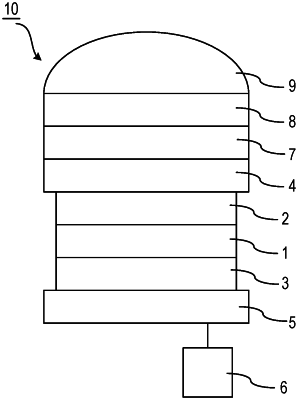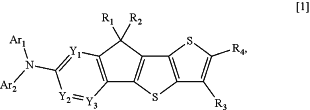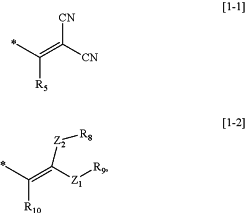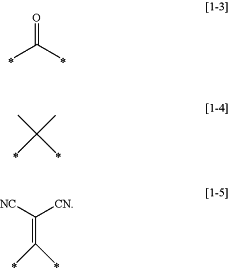| CPC H10K 85/636 (2023.02) [C07D 495/04 (2013.01); H04N 25/75 (2023.01); H10K 85/215 (2023.02); H10K 85/633 (2023.02); H10K 85/6576 (2023.02); H10K 30/30 (2023.02); H10K 85/211 (2023.02); H10K 85/615 (2023.02)] | 21 Claims |

|
1. An organic compound, which is represented by general formula [1]:
 wherein, in the general formula [1], Ar1 and Ar2 are each an aryl group, the Ar1 and the Ar2 may each have a halogen atom, a cyano group, an alkyl group, an alkoxy group, an aryl group, or a heteroaryl group as a substituent, the alkyl group, the alkoxy group, the aryl group, or the heteroaryl group serving as the substituent may further have a halogen atom, a cyano group, an alkyl group, or an alkoxy group as a substituent, and the Ar1 and the Ar2 may be bonded to each other to form a ring,
wherein R1 and R2 are each independently selected from the group consisting of a hydrogen atom, a halogen atom, a cyano group, an alkyl group, an aryl group having 6 to 18 carbon atoms, and a heteroaryl group having 3 to 17 carbon atoms, the alkyl group represented by any one of the R1 and the R2 may have a halogen atom as a substituent, the aryl group having 6 to 18 carbon atoms, and the heteroaryl group having 3 to 17 carbon atoms each represented by any one of the R1 and the R2 may each have a halogen atom, a cyano group, an alkyl group, or an alkoxy group as a substituent, and the R1 and the R2 may be bonded to each other to form a ring,
wherein R3 is selected from the group consisting of a hydrogen atom, a halogen atom, a cyano group, and an alkyl group, and the alkyl group represented by the R3 may have a halogen atom as a substituent,
wherein Y1 to Y3 are each independently selected from the group consisting of a methine group and a nitrogen atom, and when any one of the Y1 to the Y3 represents a methine group, the methine group may have a substituent and the substituent is each independently selected from the group consisting of a halogen atom, a cyano group, and an alkyl group, and the alkyl group serving as the substituent that the methine group has may further have a halogen atom as a substituent, and
wherein R4 represents a substituent selected from the group consisting of general formulae [1-1] and [1-2], and * in each of the following general formulae [1-1] and [1-2] represents a bonding position:
 wherein, in the general formulae [1-1] and [1-2], R5 and R8 to R10 are each independently selected from the group consisting of a hydrogen atom, a halogen atom, a cyano group, an amino group, an amide group, an alkyl group, an alkoxy group, an alkenyl group, an alkynyl group, an aryl group having 6 to 18 carbon atoms, and a heteroaryl group having 3 to 17 carbon atoms, and the R8 and the R9 are bonded to each other to form a ring, and
wherein the amino group, the amide group, the alkyl group, the alkoxy group, the alkenyl group, the alkynyl group, the aryl group having 6 to 18 carbon atoms, or the heteroaryl group having 3 to 17 carbon atoms represented by any one of the R5 and the R8 to the R10 may have a halogen atom, a cyano group, an alkyl group having 1 or more and 8 or less carbon atoms, an alkoxy group having 1 or more and 8 or less carbon atoms, an aryl group having 6 to 12 carbon atoms, or a heteroaryl group having 4 or more and 11 or less carbon atoms as a substituent, and
wherein, in the general formula [1-2], Z1 and Z2 are each independently selected from groups represented by formulae [1-3] to [1-5], and * in each of the formulae [1-3] to [1-5] represents a bonding position
 |